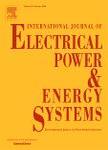版权所有:内蒙古大学图书馆 技术提供:维普资讯• 智图
内蒙古自治区呼和浩特市赛罕区大学西街235号 邮编: 010021

作者机构:Department of Electric Engineering Tokyo Metropolitan University 1-1 Minami-Osawa Hachioji-City Tokyo 192-03 Japan Kansai Electric Power Co. Inc. 3-3-22 Nakanoshima Kita-ku Osaka 530 Japan
出 版 物:《INTERNATIONAL JOURNAL OF ELECTRICAL POWER & ENERGY SYSTEMS》 (Int J Electr Power Energy Syst)
年 卷 期:1992年第14卷第5期
页 面:314-320页
核心收录:
主 题:FUZZY SET THEORY GENERATION CONTROL ECONOMIC DISPATCH AFC REGULATION CAPACITY LINE SECURITY MULTIOBJECTIVE PROGRAMMING
摘 要:This paper proposes a novel and efficient algorithm to obtain the optimal generation dispatch reflecting the operator s intention in power system rescheduling by solving a multi-objective optimization problem. In deciding the optimal system operation, various objectives, such as economy, quality and transmission security, should be attained simultaneously. However, these objectives are contradictory to each other and are in trade-off relations, thus making it difficult to handle this class of problems by conventional approaches. In the proposed algorithm, the optimal generation dispatch problem is formulated as a multi-objective optimization problem. Fuzzy coordination technique based on fuzzy set theory is used to obtain an optimal solution. Evaluation indices composed of fuel cost, transmission line overload and AFC regulation capacity margin are measured by the membership functions, and multi-objective optimization is solved by maximizing the composite performance index, namely, the fuzzy decision-making The proposed algorithm has made it possible to treat optimal dispatch problems with multiple objectives and to grasp trade-off relations between selected indices. The effect of uncertain factors pertaining to power systems can also be taken into account. The choice of membership function parameters, reflecting the operator s preference of one of the objectives, influences the overall performance of the optimization procedure. Such an approach allows system operators to decide on different preferences according to system operating conditions, thus resulting in a more flexible operation. The validity and effectiveness of the proposed approach are verified through numerical examples on the 10 mode, 5 generator system.